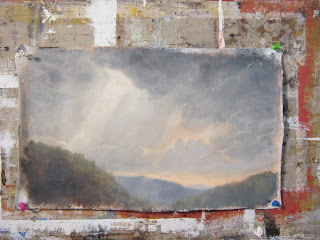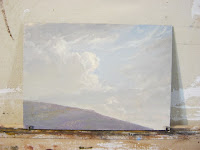 |
Erik Koeppel
Sunrise Over the Kaaterskill Creek
14 x 10 in., oil on canvas
|
Before I continue with the Kaaterskill Falls studies, I wanted to show a series of photos from a demo that I did as part of my
workshop in the Catskills this summer through the
Grand Central Academy of Art. There will be more about the workshop in
American Artist Magazine this fall.
First I chose a spot that I had painted a week before, and wanted to do further studies of at a similar hour for a larger painting. I based my demo on this painting, but backed up one more pool to study the foreground a little further. I love this spot because the sun rises in a beautiful alignment with the creek, and illuminates the trees within the riverbend while creating soft atmosphere even in the not too distant shadows.
The very smooth panel was grounded very lightly with a tint a of solvent, burnt sienna, and ochre, and I began to lay out the large elements in burnt sienna.
Once I have a basic idea of the placement of the major masses of form, I start washing in the structure of atmosphere and light with solvent, and one red, one yellow, and one blue (burnt sienna, ochre, ultramarine usually).
Here I've washed in the light blue tone of the sky (barely tinted from the ground), and begin to push forward though space lightly with washes.
As I move forward the shadows get warmer. Still no white.
Even though I know I'm planning to have a large tree in the upper left. I hold off on that until the sky is more resolved, and begin to apply some violet atmosphere into the shadows. At this point I'm starting to use a little more medium, and am applying paint to a degree that it can be manipulated more subtly.
I pass over the whole painting again from back to front this time more carefully, but always more mindful of each parts relationship to the whole space than the superficial details. If something far back is coming forward, I make the shadow cooler and lighter to set it back in space.
It's almost solid enough to paint the leaves and branches on the foreground tree.
 |
Erik Koeppel
Sunrise Over the Creek Workshop Demo
12x10 in., oil on panel
|
...And here we are. The sun has moved on to full daylight by now, but I tried to preserve my initial response to that beautiful early morning light. One hour and a half later I have a nice little study for my larger painting yet to come. Next time will be part 2 of the Making of
Kaaterskill Falls ...probably.
 Last Friday Lauren and I went painting at Boscobel, an elegant Federal period house museum set on lovely landscaped grounds with breathtaking views of the Hudson River. I was picking up two drawings from a show at the museum called, Hudson River Contemporary: Works on Paper, (catalog) organize by James McElhinney from the Art Students League. Here are the two drawings from the show, but what Lauren and I were really excited about was the fantastic 'Claudian' view of the Hudson River, which we both painted.
Last Friday Lauren and I went painting at Boscobel, an elegant Federal period house museum set on lovely landscaped grounds with breathtaking views of the Hudson River. I was picking up two drawings from a show at the museum called, Hudson River Contemporary: Works on Paper, (catalog) organize by James McElhinney from the Art Students League. Here are the two drawings from the show, but what Lauren and I were really excited about was the fantastic 'Claudian' view of the Hudson River, which we both painted. 

 When I say that the view is Claudian, I'm talking about it being 'setup' both by its natural backdrop and its composed foreground landscaping to resemble the Classical Landscape. Particularly as it was developed by Claude Lorrain. The key features are a dominant foreground tree arching over a 'stage' where the figure story is told, and then one large swoop of space around the other side of the picture to a very deep space (usually mountains and water). This compositional structure has been very popular through all subsequent ages of landscape painting because of its poetic and philosophical significance as a metaphor. The metaphor is the transition that the mind goes through in the discovery of Beauty from being focused on the human detail and worldly action of the foreground (all of which is fleeting) to the elusive unifying atmosphere of the deep space which is irridescent and intangible. The goal ultimately is to realize that the two things are in fact the same. This trancendental principle was later adapted by the Hudson River School to reflect American scenery as discussed a little here.
When I say that the view is Claudian, I'm talking about it being 'setup' both by its natural backdrop and its composed foreground landscaping to resemble the Classical Landscape. Particularly as it was developed by Claude Lorrain. The key features are a dominant foreground tree arching over a 'stage' where the figure story is told, and then one large swoop of space around the other side of the picture to a very deep space (usually mountains and water). This compositional structure has been very popular through all subsequent ages of landscape painting because of its poetic and philosophical significance as a metaphor. The metaphor is the transition that the mind goes through in the discovery of Beauty from being focused on the human detail and worldly action of the foreground (all of which is fleeting) to the elusive unifying atmosphere of the deep space which is irridescent and intangible. The goal ultimately is to realize that the two things are in fact the same. This trancendental principle was later adapted by the Hudson River School to reflect American scenery as discussed a little here.












































